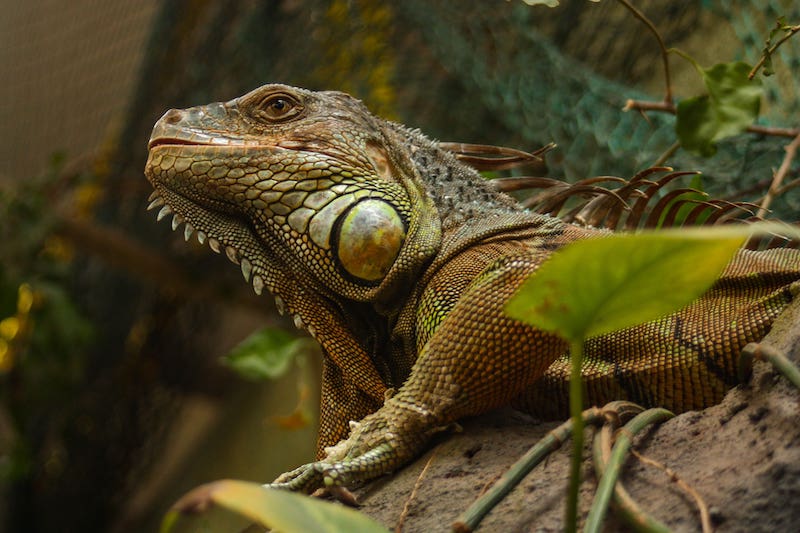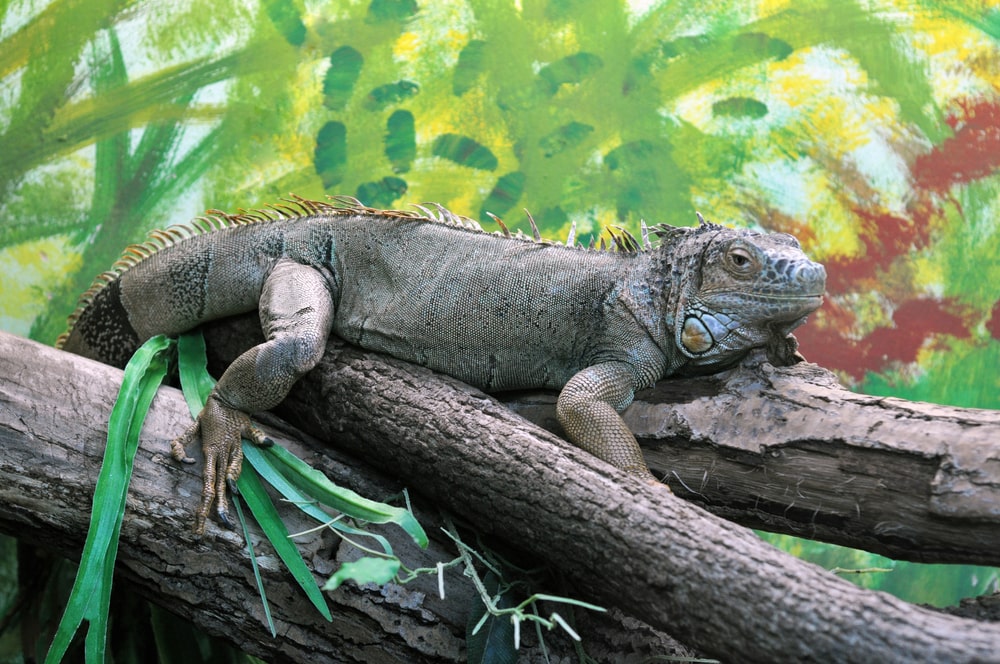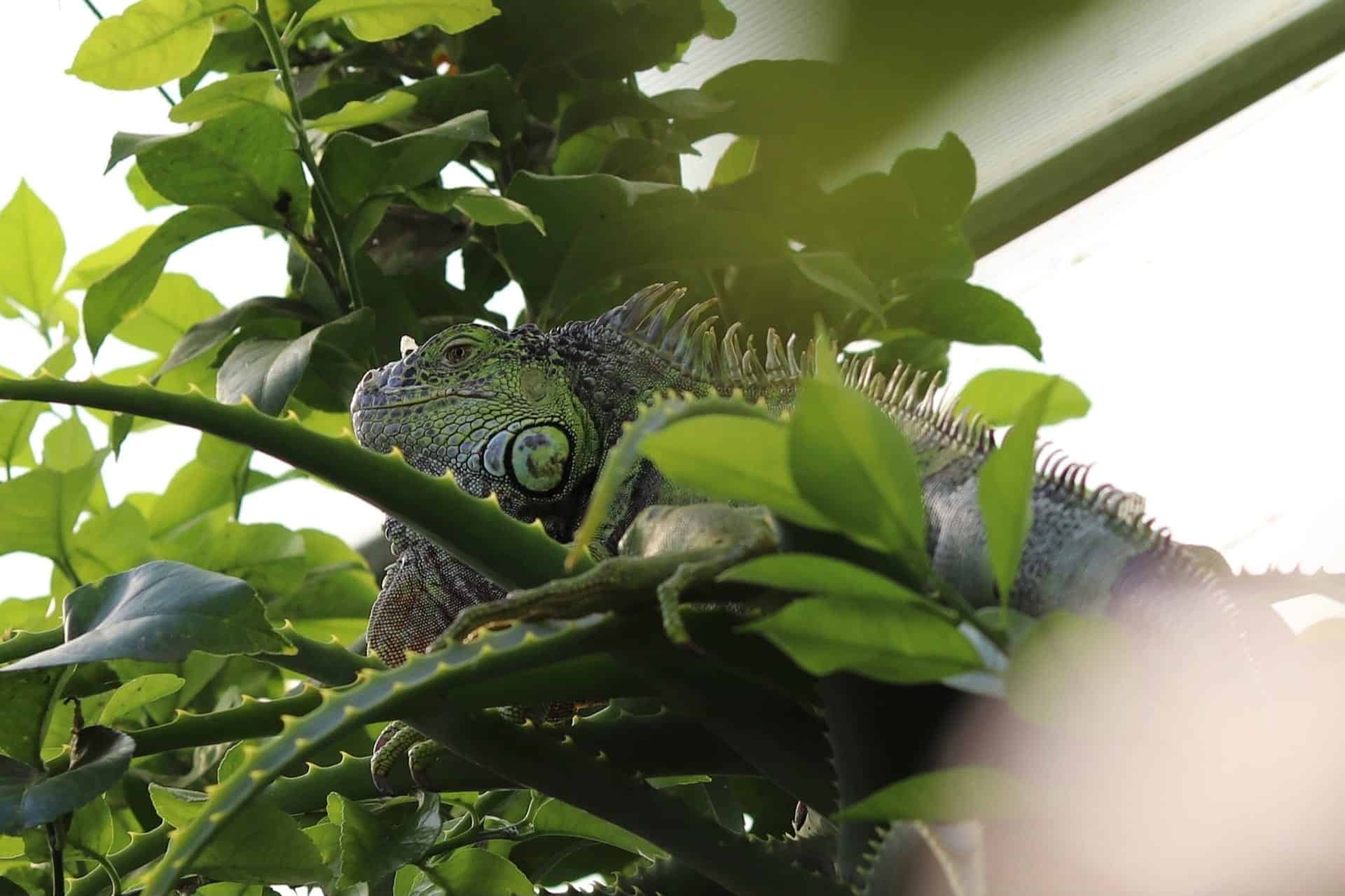Florida’s gorgeous foliage, miles of beaches, and sunshiney weather are some of the reasons people come to the state. It’s a beautiful place where you can experience great weather year-round and catch a glimpse of rare wildlife.
However, some of that wildlife isn’t all that rare, nor is it native like the other species that call Florida home. Green iguanas are an example of an invasive species running amok in Florida.
These large lizards do lots of damage in South Florida. According to the Florida Fish and Wildlife Conservation Commission, green iguanas are now on the prohibited species list. The presence of these creatures has been such an intrusion that iguana removal and iguana trapping by professionals is now encouraged to prevent further destruction.
About Green Iguanas
Green iguanas aren’t always green. This non-native species of invasive reptiles can be brown or almost black. You may even see fully grown adult green iguanas with orange or pink colors, though young green iguanas are typically bright green.
Regardless of their size, green iguanas have a row of spikes that run down the center of their neck and back, all the way down to the upper portion of the tail. Mature male iguanas have heavy jowls and a dewlap, or throat fan that distinguish them from the females. They are much larger than the ones that female iguanas have, which makes the male iguanas appear much larger.
This means they can repel rivals or warn predators to stay away. The dewlap can also attract female iguanas since they tend to gravitate toward mature male iguanas with a larger throat fan. Aside from attraction, the dewlap helps iguanas regulate their body temperature.
Take a look at the graphic below to learn some more fun facts about iguanas. They can live for up to 20 years, and they even have a third eye that helps them detect movement.

A male green iguana can grow to almost 6 feet in length and weigh up to 17 pounds, while females can get to 5 feet but don’t often surpass 7 pounds. At around the age of 2 to 4, females are at reproductive maturity.
Green iguanas usually mate in the months of October and November, nesting along riverbanks, beaches, and sandy locations. The female iguana will dig chambers for the eggs, which can span 80 feet, a network of tunnels with multiple entrances. The female will lay as many as 76 eggs during this time, which is why some form of iguana control is a necessity.
Additionally, iguanas have the potential to live up to 20 years. Even though most will live to 10 years, that gives them enough time to make a nuisance of themselves. Iguana populations have grown out of control, disrupting the lives of Florida wildlife, including gopher tortoises, sea turtles, and burrowing owls.
The Florida Fish and Wildlife Conservation Commission urges residents in South Florida to do what they can to help reduce iguana populations. Safely removing iguanas is a chore best left to the experts who can engage a variety of methods, from using iguana repellent to topography protection as part of an iguana monitoring service to help control the iguana population.
Green iguanas are a tricky invasive species because they can live on the ground in a variety of habitats, including small towns, urban areas, and suburban developments. They’re excellent swimmers and can handle saltwater and freshwater. They can even stay submerged underwater for up to 4 hours at a time.
Where Are Florida’s Green Iguanas Located?
Green iguanas originally came from South America and started appearing in South Florida in the 1960s. They’re not accustomed to cold weather, which is why they tend to stay in South Florida, as it’s similar in climate to South America.
During rare cold snaps, they are known for freezing and falling out of the trees. While it is interesting to spot an iguana out and about in South Florida, the impact this reptile species has had on the area is far too destructive to let them stay. In the 1980s, iguanas were part of the pet reptile trade. When the lizards got too large, many pet owners let them loose.
Unfortunately, this has caused a disruption in the ecosystem. Even with the Florida Fish and Wildlife Conservation Commission issuing a prohibition of green iguanas in the pet trade, these creatures continue to multiply and make a mess for homeowners as well as native species of plants and animals.
What Do Green Iguanas Eat?
Green iguanas are often enticed by the foliage on South Florida properties. They eat leaves, blossoms, and fruit plants including hibiscuses, firebush, jasmine, and Washington fan palms.
They also snack on ornamental plants, garden greens, melons, and squash. While they are herbivores, green iguanas will eat other animals. It’s not uncommon for juvenile green iguanas to eat tree snails while mature green iguanas feast upon bird eggs and dead animals.
Damage Caused by Green Iguanas
If you see a green iguana on your property, you should be concerned. Once exotic pets, they now roam the landscape with such frequency that South Florida has a serious iguana problem.
Even if you don’t mind the presence of large lizards, spotting one iguana usually means many more are out of sight. Those with private properties should take steps to remove iguanas before the damage spirals out of control.
Green iguanas can cause expensive destruction in a number of ways:
Damage to Residential and Commercial Landscaping
Since iguanas are attracted to lush landscaping, they will destroy your gardens. They consume nickerbean, which is the host plant of the endangered Miami Blue butterfly. They also eat endangered tree snails throwing off the balance of the delicate ecosystem.
Destruction of Structures

The invasive species of green iguana also leads to the destruction of various structures. By digging burrows, they puncture seawalls, tear up sidewalks, destroy foundations by digging underneath houses, and even claw holes into the roofs of unsuspecting homeowners.
Distribute Dangerous Salmonella Bacteria
Iguanas leave droppings everywhere, which smells unpleasant. Even worse though, these droppings carry salmonella which can get into water. Simply touching a surface with iguana droppings, such as your boat, dock, pool deck, or even pool furniture, can lead to you or your pets becoming ill from bacteria.
What You Can Do to Keep Green Iguanas Away
If you want to avoid having green iguanas overrun your property, there are a few things you can do to help keep the population under control:
Avoid Certain Souvenirs
When you travel to other places, stay away from plants, fruits, and vegetables when choosing souvenirs to bring home. Many of them can have non-native creatures like iguanas hiding in them.
Change Your Plants
Having a beautiful yard enhances the way your home looks. However, if iguanas like to eat what you have growing, they’ll make a mess of it and take over your land. Swap out common attractants for other native species of plants to keep them from being enticed by what is growing in your garden.
Fill Holes
Frequently walk through your property and look for holes. If you spot them, you can discourage burrowing by filling those holes with rocks.
Hang Wind Chimes
In addition to filling holes to discourage burrowing, hanging wind chimes will make the kind of noises that iguanas don’t like. Any items that make noises in random intervals are ideal for safely and naturally keeping iguanas away.
Use Reflective Surfaces
Iguanas do not like to see their reflections. You can hang mirrors or anything with reflective surfaces, such as old CDs, around your yard to scare them away.
Try Spraying Them
As much as iguanas enjoy swimming, they do not like being sprayed with water. Feel free to take aim with your hose or set up sprinklers to go off at intervals.
Don’t Release a Green Iguana into the Wild

If you currently own a green iguana as a pet and find it’s too cumbersome to care for, don’t just let it loose. Seek a pet rescue to help safely relocate it. The reason there is such a huge problem with green iguanas and other invasive animals is that people once kept them as pets and then let them go. Pet owners must be responsible when it comes to hosting an invasive species like iguanas. If you no longer want to take care of it, there are rescue groups that will help you.
How to Remove Iguanas
Green iguanas are protected by anti-cruelty laws, but they are still a nuisance. You will need to follow the proper method of removing them from your property. If none of the tips mentioned above help you scare them off your land, you should seek the services of professionals.
Professionals have the proper permits and techniques to remove iguanas and humanely kill them when necessary. They also know how to check your property and monitor the area for iguanas. If you see one green iguana, there are bound to be more burrowing and causing damage. Have an iguana professional come to evaluate your property to keep them from destroying your home and yard.


